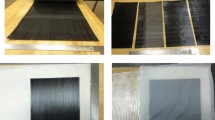Abstract
The main issues after selectively repairing an aluminum lithium alloy plate are the crack tip stress intensity factors and the residual fatigue life of the plate. Crack propagation is investigated, based on the software ABAQUS. Stress intensity factors are estimated with the FRANC3D software. The fatigue crack growth rate is calculated with the NASGRO equation and the Paris equation. The fatigue residual life and a–n curve of repair structure are obtained by the post-processing under the conditions of different repair structure sizes. The study demonstrates that a structural repair having a relative length of 50%, relative width of 35.7% and relative thickness of 83.3% increased the residual fatigue life.

















Similar content being viewed by others
Abbreviations
- \(a\) :
-
Crack length
- a 0 :
-
Initial crack length
- a c :
-
Final crack length
- \(c\) :
-
Material constant of the Paris
- \(c^{{\prime }}\) :
-
Material constant after improved
- \(f\) :
-
Fatigue crack opening function
- \(K\) :
-
Stress intensity factor
- K c :
-
Fracture toughness
- \(n\) :
-
Material constant of the Paris
- N:
-
Life
- \(n^{{\prime }}\) :
-
Material constant after improved
- R :
-
Stress ratio
- \(w\) :
-
Plate width
- \(\Delta {\text{K}}\) :
-
Amplitude of stress intensity factor
- \(\Delta K_{P}\) :
-
Amplitude of stress intensity factor after repaired
- \(\Delta K_{U}\) :
-
Amplitude of stress intensity factor after repaired
- \(\Delta K_{\mathrm{th}}\) :
-
Threshold value of stress intensity factor
- β :
-
Shape factor
- σ :
-
Stress
References
Q.Y. Wang, R.M. Pidaparti, Static characteristics and fatigue behavior of composite-repaired aluminum plates. Compos. Struct. 56(2), 151–155 (2002)
D.C. Seo, J.J. Lee, Fatigue crack growth behavior of cracked aluminum plate repaired with composite patch. Compos. Struct. 57(1–4), 323–330 (2002)
N.G. Tsouvalis, L.S. Mirisiotis, D.N. Dimou, Experimental and numerical study of the fatigue behaviour of composite patch reinforced cracked steel plates. Int. J. Fatigue 31(10), 1613–1627 (2009)
A. Baker, D. Bitton, J. Wang, Development of a proof test for through-life monitoring of bond integrity in adhesively bonded repairs to aircraft structure. Int. J. Adhes. Adhes. 36(7), 65–76 (2012)
J. Toribio, J.C. Matos, B. González, Aspect ratio evolution in embedded, surface, and corner cracks in finite-thickness plates under tensile fatigue loading. Appl. Sci. 7(7), 746 (2017)
E. Giner, N. Sukumar, J.E. Tarancón et al., An Abaqus implementation of the extended finite element method. Eng. Fract. Mech. 76(3), 347–368 (2009)
Y.U. Shi-Guang, Z. Ru-Peng, Calculation of 3D fatigue crack greatest stress intensity factor based on FRANC3D. Mech. Eng. 6, 108–110 (2008)
S.W. Kang, K.S. Jeong, A parametric numerical analysis of stress intensity factors on multiple interacting surface cracks in T-butt joints using FRANCE3D. Fract. Mech. Appl., 123–128 (2008)
E. Poursaeidi, M. Salavatian, Failure analysis of generator rotor fan blades. Eng. Fail. Anal. 14(5), 851–860 (2007)
E. Poursaeidi, M. Salavatian, Fatigue crack growth simulation in a generator fan blade. Eng. Fail. Anal. 16(3), 888–898 (2009)
H. Haeri, Experimental and numerical study on crack propagation in pre-cracked beam specimens under three-point bending. J. Cent. South Univ. 23(2), 430–439 (2016)
S. Zouari, M. Maatar, T. Fakhfakh et al., Following spur gear crack propagation in the tooth foot by finite element method. J. Fail. Anal. Prev. 10(6), 531–539 (2010)
R. Shao, P. Jia, F. Dong, Dynamic characteristics of cracked gear and three-dimensional crack propagation analysis. Proc. Inst. Mech. Eng. Part C 227(6), 1341–1361 (2013)
M. Aygül, M. Al-Emrani, Z. Barsoum et al., An investigation of distortion-induced fatigue cracking under variable amplitude loading using 3D crack propagation analysis. Eng. Fail. Anal. 45(45), 151–163 (2014)
Zhenqi. Sun, Research on the Selective Enhancement Process and Crack Inhibition Mechanism for Al–Li Alloy Structure of Aviation (Central South University, Changsha, 2013). (in Chinese)
L.A. James, W.E. Anderson, A simple experimental procedure for stress intensity factor calibration. Eng. Fract. Mech. 1(3), 565–568 (1969)
R.G. Forman, S.R. Mettu, Behavior of surface and corner cracks subjected to tensile and bending loads in Ti-6Al-4 V alloy. In: Fracture Mechanics: 22nd Symposium, ed. by H.A. Ernst, A. Saxena, D.L. McDowell, ASTM STP 1131, American Society for Testing and Materials, Vol. 1 (Philadelphia, 1992), pp. 519–546
A.A. Baker, R. Jones (ed.), Bonded Repair of Aircraft Structure. Part of the Engineering Application of Fracture Mechanics book series (EAFM), Vol 7 (Springer, Dordrecht, 1988)
F. Erdogan, M. Ratwani, Stress distribution in bonded joints. J. Compos. Mater. 5(3), 378–393 (1971)
M.M. Ratwani, Characterization of Fatigue Crack Growth in Bonded Structures, Vol. 1. Crack Growth Prediction in Bonded Structures (1977)
Funding
This research was supported by National Natural Science Foundation of China (51575535), Grants from the Project of Innovation-driven Plan in Central South University (2015CX002), Science and Technology Planning Project of Hunan Province, China (2016RS2015).
Author information
Authors and Affiliations
Corresponding author
Ethics declarations
Conflict of interest
The authors declare that there is no conflict of interest regarding the publication of this paper.
Rights and permissions
About this article
Cite this article
Liao, Y., Li, Y., Huang, M. et al. Residual Fatigue Life Analysis of Cracked Aluminum Lithium Alloy Plates Repaired with Titanium Alloy Patches for Different Sizes. J Fail. Anal. and Preven. 19, 258–269 (2019). https://doi.org/10.1007/s11668-019-00579-0
Received:
Revised:
Published:
Issue Date:
DOI: https://doi.org/10.1007/s11668-019-00579-0




